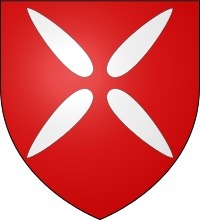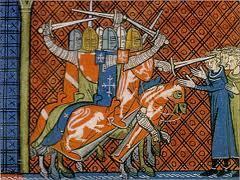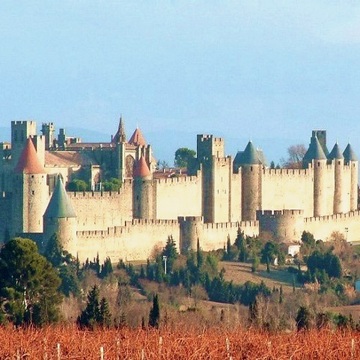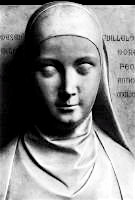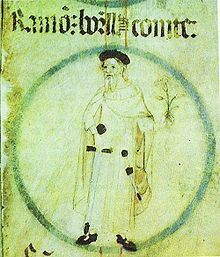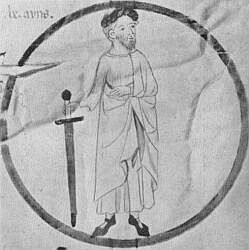maximum test » Ermessende "Ermesinda" de Carcassonne comtesse consort de Barcelone (± 975-1058)
Personal data Ermessende "Ermesinda" de Carcassonne comtesse consort de Barcelone
Source 1- Nickname is Ermesinda.
- She was born about 975Carcassonne
Languedoc-Roussillon France. - Profession: Grevinne.
- She died on March 1, 1058Carcassonne
Languedoc-Roussillon France. - She is buried March 1058 in The Cathedral of St. Mary of GironaGirona
Catalonia Spain. - A child of Rogièr I 'lo Vièlh' de Comenge and Adelais de Rouergue
Household of Ermessende "Ermesinda" de Carcassonne comtesse consort de Barcelone
She is married to Ramon Borrell I Borell de Barcelona.
They got married on January 20, 992 at Barcelona, Catalonia, Spain.
Child(ren):
Notes about Ermessende "Ermesinda" de Carcassonne comtesse consort de Barcelone
Name Suffix:Of Foix
Name Suffix:Of Foix
Ermensinda var grevinne av Carcasona og Barcelona.
Hun var enke etter greve Ermengaud av Urgel som vistnok var bror til hennes annen
mann. De hadde sønnen Ermengaud som i 1010 enda var et barn. Hennes mor var Adelaide.
Det fremgår av et dokument undertegnet av Wilhelm, Miron og Roger Pons av Narbonne.
Ermensinda skal ha vært barmhjertig, klok og dyktig i sitt styre av de grevskaper
(Barcelona, Gerona, Ausona og Manrese) som hennes mann hadde etterlatt henne. Han ga
henne rett til å styre disse så lenge hun selv ønsket det. Raimund døde i 1017, hvoretter hun
var formynder for sin sønn Berengar Raimund. I 1023 overga hun grevskapene på visse
betingelser, han var da allerede gift med Sancia. Da han døde i 1035, overtok Ermensinda
igjen styret, hennes sønnesønn, Raimund Berengar, var nærmest bare greve i navnet. Da hun
stadig nektet å overgi styret til ham, mishandlet han henne, vistnok med støtte av sin hustru,
Almodis. Ermensinda klaget til pave Victor II som ga henne medhold og ekskommuniserte
Raimund Berengar og Almodis.
Først ved et dokument av 04.06.1057 overdro hun til ham grevskapene for 1000
gulluncer. Av alt dette må man slutte at hun var meget herskesyk og vel også gjerrig.
Ermensinda trakk seg nå tilbake til slottet Quircie i Ausona og døde der. I ?Enciclopedia
universal illustrada Evropo - Americana? angis at hun døde 85 år gammel på borgen Besona i
grevskapet Ausona. Hun ble bisatt i katedralen i Gerona.
Rootsweb Feldman
URL: http://worldconnect.genealogy.rootsweb.com/cgi-bin/igm.cgi?op=GET&db=:3044567&id=I06334
# ID: I06334
# Name: Ramón I Borrel Of BARCELONA 1 2 3 4 5 6
# Sex: M
# Birth: 972 in of, Barcelona, Barcelona, Spain 1 2 3 4 5 6
# Death: 25 FEB 1017/18 2 3 4 5 6
# Event: TITL Count of Barcelona 1 2 3 4 5 6
# Change Date: 15 JAN 2004 6
# Change Date: 2 OCT 2001 3 4 5 6
# Note:
[Joanne's Tree.1 GED.GED]
2 SOUR S332582
3 DATA
4 TEXT Date of Import: 14 Jan 2004
[daveanthes.FTW]
OCCU Count of Barcelona ...
SOUR Royalty for Commoners, Roderick W. Stuart
HAWKINS.GED
gendex.com/users/daver/rigney/D0001 says 927
PAGE 38
QUAY 1
SOUR COMYNI.GED (Compuserve) says ABT 1017
Royalty for Commoners, Roderick W. Stuart, p. 38 says 25 Feb 1018
HAWKINS.GED & gendex.com/users/daver/rigney/D0001 says 25 Feb 1019
Ramon I Borrel - COMYNI.GED (Compuserve); Raymond Borrel I, Count of Barcelona
, Gerona and Osona - Royalty for Commoners, Roderick W. Stuart, p. 38;
BERENGAR (Raymond Borrell III); acceded 992 - gendex.co
m/users/daver/rigney/D0001
Father: Borrell II (De Urgel) Of BARCELONA b: 948
Mother: Luitgarde DE TOULOUSE b: ABT 942
Marriage 1 Ermensinde Of CARCASSONNE** b: ABT 972 in of, Carcassonne, Aude, France
* Married: 20 JAN 989/90 1 2 3 4 5 6
Children
1. Has Children Estefania de BARCELONA b: 980 in
2. Has Children Godeheut BORELL b: 995 in Of, Tosni, France
3. Has Children **Adaele MRS , Countess Of Evreux Toni De b: ABT 1004 in Normandy, France
4. Has Children Ramon THE , Count Of Barcelona Berenger Crooked' b: 1005 in Barcelona, Spain
Sources:
1. Title: woodward.FTW
Repository:
Call Number:
Media: Other
Text: Date of Import: Nov 7, 2000
2. Title: daveanthes.FTW
Note: ABBR daveanthes.FTW
Note: Source Media Type: Other
Repository:
Call Number:
Media: Book
Text: Date of Import: 14 Jan 2004
3. Title: daveanthes.FTW
Note: ABBR daveanthes.FTW
Note: Source Media Type: Other
Repository:
Call Number:
Media: Book
Text: Date of Import: Jan 13, 2004
4. Title: Spare.FTW
Repository:
Call Number:
Media: Other
Text: Date of Import: Jan 18, 2004
5. Title: Spare.FTW
Repository:
Call Number:
Media: Other
Text: Date of Import: 21 Jan 2004
6. Title: Joanne's Tree.1 GED.GED
Repository:
Call Number:
Media: Other
Text: Date of Import: Feb 6, 2004
{geni:about_me} https://pt.wikipedia.org/wiki/Ermesinda_de_Carcassonne
Daughter of Roger de Comminges "le Vieux", Comte de Carcassonne, de Razès, de Couserans et de Comminges, Seigneur de Foix and his wife Adelais.
Her parentage is confirmed by the charter dated 2 Sep 1019 which names “Raymondus…comes Borreli comitis proles” and by which “Ermisindi…coniux eius comitissa, filia…comitis Carcasonensis Rodegarii” records her husband´s burial “infra canonicalem claustram S. Crucis sedis” and confirms a donation by “femina…Bellazez uxor quæ fuit Sesemundi fratris Seniofredi Gerundensis vicecomitis”, with the consent of “filio suo domno Barengario marchione comite…Amato vicecomite Gerundense…”[432]. "Remundus comes et marchio, Ermensides comitissa" donated property to Saint-Victor, Marseille by charter dated 11 Jun 996[433]. "Ermessindis comitissa et Amato de castro Surice et Sunifredo de Riorubio, Gondebaldus de Besora, Lobeto de Celra" signed a document dated 12 Nov 1018 as executors of "condam Remundo comite et marchio"[434]. Regent during the minority of her son until early 1020s. She acquired considerable power during her regency, quarrelling with her son. She continued to be a disruptive influence in Catalonia until her death[435]. The testament of "Ermesindis comitissa", dated 25 Sep 1057, names "domnum Raymundum Berengarium comitem nepotem meum…domna Almodis comitissa coniuge vestra"[436]. The codicil of "domna Ermesindis comitissa", dated 6 Mar 1057 (O.S.), names "Guillermo Berengarii suo nepoti…Sancio suo nepoti…Bernardo Berengarii suo nepoti"[437]. m ([990/91]) RAMON BORRELL I Comte de Barcelona, son of BORRELL [II] Comte de Barcelona & his first wife Ledgarde [de Toulouse] ([971/26 May 972]-25 Feb 1017).
source: Foundation for Medieval Genealogy http://fmg.ac/Projects/MedLands/TOULOUSE%20NOBILITY.htm#RaymondRogerCarcassonnedied1011A
http://es.wikipedia.org/wiki/Ermesenda_de_Carcasona
Ermesenda o Ermesinda de Carcasona ( 972 - Gerona, 1 de marzo de 1057 ), fue regente del Condado de Barcelona con los títulos de condesa de Barcelona, condesa de Gerona y condesa de Osona. Hija de Roger I de Cominges o Rogerio el Viejo, conde de Carcasona, y de Adelaida de Gévaudan (Francia). Casó hacia 992 con Ramón Borrell, que sucedió el 30 de septiembre del mismo año, después de su casamiento, a su padre Borrel II, en el gobierno del condado de Barcelona.
--------------------
Ermesinde of Carcassonne (972-1057) was married to Ramon Borrell, Count of Barcelona. While he lived she was politically active and presided over assemblies and tribunals. After his death in 1018 she became regent for their son Berenguer Ramon I until 1023. After this, she continued to wield power. In contrast to her son, she favored war with the Muslim powers to the South, partly because of the discontent of the nobles at his police of peace. When he died in 1035, she became regent for her grandson until he was declared to be of age in 1044.
--------------------
http://en.wikipedia.org/wiki/Ermesinde_of_Carcassonne
--------------------
Ermesinde of Carcassonne (972-1057) was married to Ramon Borrell, Count of Barcelona. While he lived she was politically active and presided over assemblies and tribunals. After his death in 1018 she became regent for their son Berenguer Ramon I until 1023. After this, she continued to wield power. In contrast to her son, she favored war with the Muslim powers to the South, partly because of the discontent of the nobles at his police of peace. When he died in 1035, she became regent for her grandson until he was declared to be of age in 1044.
--------------------
Ermesinde of Carcassonne (972-1057) was married to Ramon Borrell, Count of Barcelona. While he lived she was politically active and presided over assemblies and tribunals. After his death in 1018 she became regent for their son Berenguer Ramon I until 1023. After this, she continued to wield power. In contrast to her son, she favored war with the Muslim powers to the South, partly because of the discontent of the nobles at his police of peace. When he died in 1035, she became regent for her grandson until he was declared to be of age in 1044.
[edit] References
Familypedia has a page on Ermessinde de Carcassonne (972-1057).
" Women in power 1000-1100" from Guide2womenleaders.com, last accessed January 15, 2007
--------------------
Ermesinde of Carcassonne
From Wikipedia, the free encyclopedia
Ermesinde of Carcassonne (972-1057) was married to Ramon Borrell, Count of Barcelona. While he lived she was politically active and presided over assemblies and tribunals. After his death in 1018 she became regent for their son Berenguer Ramon I until 1023. After this, she continued to wield power. In contrast to her son, she favored war with the Muslim powers to the South, partly because of the discontent of the nobles at his police of peace. When he died in 1035, she became regent for her grandson until he was declared to be of age in 1044.
[edit]References
" Women in power 1000-1100" from Guide2womenleaders.com, last accessed January 15, 2007
Ermesinde, regente de Barcelona1,2
b. circa 972, d. 1 March 1057
FatherRoger I "el Viejo", comte de Comminges3 b. circa 945, d. after April 1011
MotherAdelais de Pons3 b. circa 945, d. after April 1011
Ermesinde, regente de Barcelona was the daughter of Roger I, comte de Carcassone, and Adelais, sister of Baldwin de Pons.4 Also called Ermesende de Foix.5 She was born circa 972. She was the daughter of Roger I "el Viejo", comte de Comminges and Adelais de Pons.3 Ermesinde, regente de Barcelona married Ramón Borrell, conde de Barcelona, son of Borrell II, conde de Barcelona, Gerona y Ausona and Luitgarde de Toulouse, between 990 and 991.1,4 Ermesinde, regente de Barcelona was a witness where Berenguer Ramón I "el Curvo", conde de Barcelona, Gerona y Ausona entirely under the control of his mother -- but made some settlement of the political conditions of the country, by recognizing, granting or codifying the fueros and liberties of Barcelona, which at that time included Gerona, Ausona and Manresa between 1018 and 1035.6 Ermesinde, regente de Barcelona entirely controlled the county of Barcelona, then ruled by her son Berenguer-Ramon I, between 1018 and 1035. She established herself in Gerona and claimed the greater part of her grandson, Ramon Berenguer I's, dominions as her own circa 1036.6 She was a witness where Ramón Berenguer I "el Viejo", conde de Barcelona able to extend his influence in two directions after a preliminary struggle with his grandmother, who had established herself in Gerona and claimed the greater part of his dominions as her own, and extended his frontiers as far as Barbastro by conquests from the Moors; and in other directions, more especially in the south, where Moorish chieftains and governors paid him tribute and acknowledged his supremacy.6 Ermesinde, regente de Barcelona died on 1 March 1057.1,4 Ermesinde, regente de Barcelona was buried in the Cathedral, Girona, Catalonia, Spain.
Family
Ramón Borrell, conde de Barcelona b. 972, d. 1018
Children
Berenguer Ramón I "el Curvo", conde de Barcelona, Gerona y Ausona+ b. 1000, d. 6 Apr 10355
Adelaide de Barcelona+ b. 1004, d. 10512
Citations
[S204] Roderick W. Stuart, RfC, 291-34.
[S1316] Reyes y Reinos Genealogias, online www.homar.org, España - 09.F.
[S204] Roderick W. Stuart, RfC, 291-35.
[S438] Theroff's Royal Genealogies, online http://pages.prodigy.net/ptheroff/, Foix.txt.
[S935] LUIS K. W. (e-mail address), Re: Sibil de Barcelona? In "Re: Sibil de Barcelona?," newsgroup message 2001-05-27 07:53:50 PST.
[S512] H. J. Chaytor, Chaytor, H. J., chap. 3.
--------------------
Ermesenda de Carcasona (972-1058) o Ermesinda, fue una de las mujeres que ostentaron mayor poder real en toda la Edad Media europea, y seguramente también llegaríamos al Renacimiento y lo sobrepasaríamos. Una mujer enérgica, que no duda en acompañar a su marido en el campo de batalla montada a caballo, desafiando las convenciones. Un ser extraordinario en un mundo de hombres, y hombres muy brutos, pues en aquel tiempo lo que sabían hacer mejor en el Condado de Barcelona era la guerra.
Dudo mucho que hoy existan mujeres que gobiernen tanto y durante tanto tiempo como lo hizo ella. No se me ocurre ningún ejemplo, a excepción de Isabel la Católica, aunque ella gobernó junto a su esposo y, si la memoria no me falla, no excomulgó a ninguno de sus nietos.
--------------------
http://en.wikipedia.org/wiki/Ermesinde_of_Carcassonne
Ermesinde of Carcassonne
From Wikipedia, the free encyclopedia
Jump to:navigation, search
Ermesinde of Carcassonne (972-1057) was married to Ramon Borrell, Count of Barcelona. While he lived she was politically active and presided over assemblies and tribunals. After his death in 1018 she became regent for their son Berenguer Ramon I until 1023. After this, she continued to wield power. In contrast to her son, she favored war with the Muslim powers to the South, partly because of the discontent of the nobles at his police of peace. When he died in 1035, she became regent for her grandson until he was declared to be of age in 1044.
[edit] References
Familypedia.jpg Ermessinde de Carcassonne (972-1057) on Familypedia
This page was last modified on 29 October 2009 at 18:58.
--------------------
Ermesenda o Ermesinda de Carcasona (972 – Gerona-San Quirico de Besora 1 de marzo de 1057) gobernó en condominio los condados de Barcelona, Gerona y Osona y fue tutora de su hijo Berenguer Ramón I y de su nieto Ramón Berenguer I durante sus respectivas minorías de edad. Hija de Roger I de Cominges o Rogerio el Viejo, conde de Carcasona, y de Adelaida de Gévaudan (Francia). Casó hacia 992 con Ramón Borrell, que sucedió el 30 de septiembre del mismo año, después de su casamiento, a su padre Borrel II, en el globierno del condado de Barcelona.
Era Ermesenda de singular hermosura y enérgico carácter. Por largo tiempo figuró en la corte de Barcelona, ya rodeada de los jueces de corte y sentada en el escaño del Tribunal administrando justicia en presencia de sus vasallos, tanto conjuntamente con su esposo como durante sus ausencias, ya cabalgando al lado de este en la guerra y acompañándole en sus expediciones militares. Asimismo, Ramón Borrell le entregó en propiedad una gran cantidad de castillos y plazas fuertes en los condados de Barcelona, Osona y Manresa, lo que le proporcionó un enorme poder político y capacidad económica. Muy unida a su esposo, la mayoría de documentos de la corte condal de esta época aparecen expedidos por ambos.1
Período de cogobierno con su hijo Berenguer Ramón I
Murió Ramón Borrell legando la corona a su primogénito Berenguer Ramón I, apodado "el Curvo", quien aún era menor de edad al producirse el fallecimiento, y a su esposa Ermesenda, a fin de que gobernasen juntos. Aunque el testamento original no se ha conservado, documentos posteriores no dejan lugar a dudas de que Ramón Borrell estableció un auténtico régimen de cogobierno entre su viuda y su hijo. Así pues, empuñó las riendas del gobierno la condesa viuda Ermesenda, quien siguió gobernando conjuntamente con su hijo incluso después de que este alcanzara la mayoría de edad.2
Alrededor del año 1018, Ermesenda llamó a una gavilla de normandos que pirateaban por el Mediterráneo, acaudillados por su capitán Roger de Tosny, para pelear contra los sarracenos que infestaban las costas de Cataluña y que formaban la soldadesca de Mudjehid, emir de Denia y de las Baleares. Acudiendo a este llamamiento los normandos, mataron innumerables legiones de musulmanes y se apoderaron de muchas ciudades y castillos. El emir Mudjehid pidió finalmente la paz a Ermesenda y se ofreció a pagar tributo a los barceloneses. Ermesenda, agradecida con el servicio que le prestó Roger, lo casó con una hija suya en recompensa.
Con el paso del tiempo, Berenguer Ramón I intentó resistirse a la intervención de su madre en el gobierno de sus condados, originándose así graves conflictos entre ellos. Gracias a la mediación del obispo de Gerona, Pedro, hermano de Ermesenda, se estableció un convenio entre madre e hijo, convenio que la misma Ermesenda cita en el sacramental que prestó a su hijo en 1024, empeñándole treinta castillos con sus pertenencias en seguridad de la paz y pactos que le había jurado, y prometía de nuevo guardarle en recíproca de otro empeño y sacramental de la misma clase que su hijo le había también otorgado; pero se ignora cuáles fueron los pactos que aquí se citan, no pudiéndose inferir, por la absoluta independencia con la que luego gobernó el conde, que hubiesen convenido madre e hijo en gobernar simultáneamente, como suponen Diago y Pujades.
Disputas con Ramón Berenguer I y reconciliación
Algunos escritores] han afirmado que Ramón Berenguer I "el Viejo", sucesor (1035) de su padre Berenguer Ramón I, estuvo también bajo la tutela de su abuela Ermesenda; pero es un error el creerlo así después de los documentos sacados a plaza por don Próspero de Bofarull. No puede negarse que Ermesenda quiso y logró realmente introducirse algunas veces, después de la tutela, en el gobierno de su hijo Berenguer Ramón, y que, aprovechándose de la prematura muerte de su hijo y de la menor edad de su nieto Ramón Berenguer, volvió en esta ocasión a su tenaz propósito de mandar; pero en ningún documento se apoyan los que creen en esa tutela, y, por el contrario, todos los datos que existen inducen a probar otra cosa muy distinta. "Si examinamos el testamento del conde Ramón Berenguer I el Curvo (dice don Próspero de Bofarull), que es quien como padre debió prevenir un caso tan interesante como éste, hallaremos que ni mención siquiera hizo de su madre doña Ermesenda, ni ordenó la menor cosa en cuanto a la tutela de su primogénito y sucesor don Ramón, antes le supone entonces en estado y aptitud, no sólo de poder gobernar sus condados, si que también los de sus hermanos Sancho y Guillermo, a quienes deja bajo la bailía o tutela del mismo primogénito, ya fuese porque la prematura prudencia, talento y prendas de este hijo le dispensasen de la dependencia de un tutor, o ya porque a hurtadillas de su madre doña Ermesenda, de la que tenía sobrados motivos para desconfiar, hiciese este encargo en diferente documento, que se nos oculta, a alguno, o mejor a todos los magnates o señores de sus Estados, confiándoles el gobierno de ellos durante la peregrinación a Roma que proyectaba, como así lo dio a entender después el mismo primogénito y conde don Ramón en la carta de dote que el año 1039 hizo a favor de su primera esposa doña Isabel, cuando dice que contraía aquel matrimonio "per voluntatem Dei atque seniorum (magnates) electione" sin nombrar tampoco a su abuela doña Ermesenda de la que seguramente recelaba ya en su primera edad. Es cierto, sin embargo, que ésta disputó constantemente con su nieto. Éste repudió a Blanca, su segunda esposa, y contrajo nuevo matrimonio con Almodis de la Marca. Su abuela, aprovechándose quizá del repudio de Blanca, consiguió que el Papa Víctor II lanzara contra los condes de Barcelona una doble excomunión instada la una, según parece, por Ermesenda, y la otra por la misma Blanca.
Durante las regencias de Ermesenda, la aristocracia inició el proceso de feudalización de Cataluña, enfrentando a los príncipes con la Iglesia. Ermesenda recibió el apoyo de consejeros como Gombau de Besora, el juez Ponce Bonfill Marc y el abad de Ripoll, así como de su hermano Pedro Roger de Carcasona, obispo de Gerona. También colaboraron los prelados partidarios de la reforma gregoriana como el Abad Oliba.
Ermesenda se ocupó de la iglesia y animó nuevas fundaciones, como el capítulo de la Catedral de Gerona, el monasterio femenino de San Daniel en Gerona o el masculino de Sant Feliu de Guixols. Ermesenda llegó por fin a acuerdos con su nieto cediendo, el 4 de julio de 1056, a los condes Ramón Berenguer y Almodis todos sus derechos al condado de Barcelona y a varios castillos, por el precio de 1000 onzas de oro. Prestó Ermesenda a sus nietos los debidos juramentos y comprometió a hacer levantar las excomuniones que el Papa Víctor II les había impuesto a causa suya y de la repudiada Blanca. Las 1000 onzas de oro que cobró las invirtió en la fábrica del tabernáculo de la catedral de Gerona, de la que era muy devota y bienhechora, y proyectó en seguida a realizar una peregrinación a las iglesias de los Apóstoles Santiago de Galicia y San Pedro y San Pablo de Roma, por lo cual otorgó testamento a 25 de septiembre de 1056, con importantes donaciones a Roma, nombrando albacea a su mismo nieto, si bien luego le revocó esta confianza. Se ignora si llevó realmente a cabo esta peregrinación proyectada, pero es de suponer que no fuese así, atendida su avanzada edad de ochenta y cinco años y su muerte inmediata, que tuvo lugar el 1 de marzo de 1057 en la casa que habitaba en el condado de Osona cerca de la iglesia de San Quirico de Besora y Santa Julita. Fue enterrada en la catedral de Gerona.
(Fuente: Wikipedia)
--------------------
Pedigree Resource File
Ver a la persona en el modo de cuadro genealógico
name:
Ermensinde /DeCarcassonne/
sexo: female
nacimiento: 0975
Carcassonne, Aude, Languedoc-Roussillon, France
defunción: 1 March 1058
Carcassonne, Aude, Languedoc-Roussillon, France
matrimonio: 0992
Barcelona, Barcelona, Catalonia, Spain
Padres
Padre: Roger I /DeComminges/
madre: Adelaide /DeRouergue/
Matrimonios (1)
cónyuge: Raimund /Borrel/
matrimonio: 0992
Barcelona, Barcelona, Catalonia, Spain
Ocultar hijos (4)
Notas (2)
AFGS
2 _APID 1030
Quoted Text: http://trees.ancestry.com/pt/AMTCitationRedir.aspx?tid=11197325&pid=-225276643
Fuentes (1)
1. Ancestry Family Trees
--------------------------------------------------------------------------------
Cita de este registro
"Pedigree Resource File," database, FamilySearch (http://familysearch.org/pal:/MM9.2.1/S5BC-VX8 : accessed 2014-04-22), entry for Ermensinde /DeCarcassonne/
------------------------------------------------------------------------------------------------------------
Ermesinde of Carcassonne
From Wikipedia, the free encyclopedia
This article may be expanded with text translated from the corresponding article in the Catalan Wikipedia. (August 2013)
Click [show] on the right to read important instructions before translating.[show]
Ermesinde of Carcassonne
Ermesenda de Carcasona.jpg
Reproduction of a sculpture of Ermesinde of Carcassonne by Guillem Morell (1385)
BornErmessenda de Carcassona
ca. 972
Carcassonne ?
DiedMarch 1, 1058
Sant Quirze de Besora
Ermesinde of Carcassonne (ca. 972 – March 1, 1058) was a noblewoman in southern France. She became Countess consort of Barcelona, Girona and Osona.
Ermesinde of Carcassonne was the daughter of Roger I of Carcassonne. She married Ramon Borrell, Count of Barcelona.
While he lived she was politically active and presided over assemblies and tribunals. After his death in 1018 she became regent for her son Berenguer Ramon I until 1023. After this, she continued to wield power. In contrast to her son, she favored war with the Muslim powers to the South, partly because of the discontent of the nobles at his policy of peace. When he died in 1035, she became regent for her grandson until he was declared to be of age in 1044.
Source: http://en.wikipedia.org/wiki/Ermesinde_of_Carcassonne
from "Our Folk" by Albert D Hart, Jr.
110897841. Grevinne Ermessinde ROGERSDTR av Caracasona og Barcelona (9496) was born in 972. (9497) She died in 1058 in Besona. (9498) Hun angis å være død 85 år gammel på borgen Besona i grevskapet Ausone (Vich.). Bisatt i katedralen i Gerona. She was a Grevinne in Caracasona og Barcelona.(9499) Hun var enke etter grev Ermengaud av Urgel (vistnok bror til hennes annen mann), med hvem hun hadde en sønn Ermengaud som 1010 enda var barn. At hennes mor var Adelaide, fremgår av et dokument undertegnet av Wilh,.Miron og Roger Pons av Narbonne.
Hun skal ha vært barmhjertig, klok og dyktig i sett styre av de grevskaper (Barcelona, Gerone, Ausona og Manrese) som hennes mann hadde etterlatt henne. Han ga henne rett til å styre disse så lenge hun selv ønske t det. Raimund døde i 1017, hvoretter hun var formynder for sin sønn Berengar Raimund I., hvem hun i 1023 overgav grevskapene på visse betingelser. Han var allereda da gift med Sanica, og da had døde i 1035, overtok Ermessinde igjen styret, så at hennes sønnesønn Raimund Berengar I nærmest var greve bare i navnet. Da hun stadig nektet å overgi styret til ham, mishandlet han henne, vistnok mes støtte av sin hustru Almodis. Ermessinde klaget til pave Victor II. som ga henne medhold, og lot R.B ekskommunisere, Almodis likeså. Først ved et dokument av 4.6.1057 overdor hun ham grevskapene for 1000 gulluncer. Av alt dette må man slutte at hun var adskillig herskesyk.
[spelman.FTW]
REFN: 11653
From Todd A. Farmerie to soc.genealogy.medieval:
"This marriage has always been problematic."
"I think it extremely unlikely that the daughter of Ermesinde
of Carcassonne married Richard d'Evreux."
The city of Carcassonne in southern France is divided into two
distinct areas: the Ville Basse, a contemporary section where
most of the business of the city is conducted, and the Cité,
the remnants of a medieval walled community.
French Govt. Tourist Office
"Carcassonne, France," Microsoft Encarta Encyclopedia 99.
1993-1998 Microsoft Corporation. All rights reserved.
GEDCOM line 23894 not recognizable or too long:
() 2 GIVN Ermensinde de
GEDCOM line 23895 not recognizable or too long:
() 2 SURN Carcassonne
Weis' "Ancestral Roots . . ." 108:23.
Stuart's "Royalty For Commoners" (54:34) & (291:34).
[spelman.FTW]
REFN: 11653
From Todd A. Farmerie to soc.genealogy.medieval:
"This marriage has always been problematic."
"I think it extremely unlikely that the daughter of Ermesinde
of Carcassonne married Richard d'Evreux."
The city of Carcassonne in southern France is divided into two
distinct areas: the Ville Basse, a contemporary section where
most of the business of the city is conducted, and the Cité,
the remnants of a medieval walled community.
French Govt. Tourist Office
"Carcassonne, France," Microsoft Encarta Encyclopedia 99.
1993-1998 Microsoft Corporation. All rights reserved.
GEDCOM line 23894 not recognizable or too long:
() 2 GIVN Ermensinde de
GEDCOM line 23895 not recognizable or too long:
() 2 SURN Carcassonne
Weis' "Ancestral Roots . . ." 108:23.
Stuart's "Royalty For Commoners" (54:34) & (291:34).
[spelman.FTW]
REFN: 11653
From Todd A. Farmerie to soc.genealogy.medieval:
"This marriage has always been problematic."
"I think it extremely unlikely that the daughter of Ermesinde
of Carcassonne married Richard d'Evreux."
The city of Carcassonne in southern France is divided into two
distinct areas: the Ville Basse, a contemporary section where
most of the business of the city is conducted, and the Cité,
the remnants of a medieval walled community.
French Govt. Tourist Office
"Carcassonne, France," Microsoft Encarta Encyclopedia 99.
1993-1998 Microsoft Corporation. All rights reserved.
GEDCOM line 23894 not recognizable or too long:
() 2 GIVN Ermensinde de
GEDCOM line 23895 not recognizable or too long:
() 2 SURN Carcassonne
Weis' "Ancestral Roots . . ." 108:23.
Stuart's "Royalty For Commoners" (54:34) & (291:34).
[spelman.FTW]
REFN: 11653
From Todd A. Farmerie to soc.genealogy.medieval:
"This marriage has always been problematic."
"I think it extremely unlikely that the daughter of Ermesinde
of Carcassonne married Richard d'Evreux."
The city of Carcassonne in southern France is divided into two
distinct areas: the Ville Basse, a contemporary section where
most of the business of the city is conducted, and the Cité,
the remnants of a medieval walled community.
French Govt. Tourist Office
"Carcassonne, France," Microsoft Encarta Encyclopedia 99.
1993-1998 Microsoft Corporation. All rights reserved.
GEDCOM line 23894 not recognizable or too long:
() 2 GIVN Ermensinde de
GEDCOM line 23895 not recognizable or too long:
() 2 SURN Carcassonne
Weis' "Ancestral Roots . . ." 108:23.
Stuart's "Royalty For Commoners" (54:34) & (291:34).
Timeline Ermessende "Ermesinda" de Carcassonne comtesse consort de Barcelone
This functionality is only available in Javascript supporting browsers.
Click on the names for more info.
Symbols used:  grandparents
grandparents
 parents
parents
 brothers/sisters
brothers/sisters
 children
children
 grandparents
grandparents
 parents
parents
 brothers/sisters
brothers/sisters
 children
children
Sources
Matches in other publications
This person also appears in the publication:Same birth/death day
- 1058 » Ermesinde of Carcassonne, countess and regent of Barcelona (b. 972)
- 1131 » Stephen II, king of Hungary and Croatia (b. 1101)
- 1233 » Thomas, count of Savoy (b. 1178)
- 1244 » Gruffydd ap Llywelyn Fawr, Welsh noble, son of Llywelyn the Great (b. 1200)
- 1320 » Ayurbarwada Buyantu Khan, Chinese emperor (b. 1286)
- 1383 » Amadeus VI, count of Savoy (b. 1334)
About the surname De Carcassonne
- View the information that Genealogie Online has about the surname De Carcassonne.
- Check the information Open Archives has about De Carcassonne.
- Check the Wie (onder)zoekt wie? register to see who is (re)searching De Carcassonne.
The maximum test publication was prepared by Ard van Bergen.
When copying data from this family tree, please include a reference to the origin:
Ard van Bergen, "maximum test", database, Genealogy Online (https://www.genealogieonline.nl/maximum-test/I4951911868150125164.php : accessed June 21, 2024), "Ermessende "Ermesinda" de Carcassonne comtesse consort de Barcelone (± 975-1058)".
Ard van Bergen, "maximum test", database, Genealogy Online (https://www.genealogieonline.nl/maximum-test/I4951911868150125164.php : accessed June 21, 2024), "Ermessende "Ermesinda" de Carcassonne comtesse consort de Barcelone (± 975-1058)".
